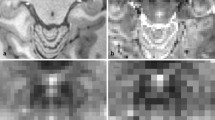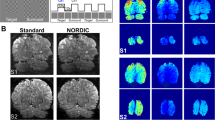Abstract
Objectives
To compare physiological noise contributions in cerebellar and cerebral regions of interest in high-resolution functional magnetic resonance imaging (fMRI) data acquired at 7T, to estimate the need for physiological noise removal in cerebellar fMRI.
Materials and methods
Signal fluctuations in high resolution (1 mm isotropic) 7T fMRI data were attributed to one of the following categories: task-induced BOLD changes, slow drift, signal changes correlated with the cardiac and respiratory cycles, signal changes related to the cardiac rate and respiratory volume per unit of time or other. \(R_{\text{adj}}^{2}\) values for all categories were compared across regions of interest.
Results
In this high-resolution data, signal fluctuations related to the phase of the cardiac cycle and cardiac rate were shown to be significant, but comparable between cerebellar and cerebral regions of interest. However, respiratory related signal fluctuations were increased in the cerebellar regions, with explained variances that were up to 80 % higher than for the primary motor cortex region.
Conclusion
Even at a millimetre spatial resolution, significant correlations with both cardiac and respiratory RETROICOR components were found in all healthy volunteer data. Therefore, physiological noise correction is highly likely to improve the temporal signal-to-noise ratio (SNR) for cerebellar fMRI at 7T, even at high spatial resolution.



Similar content being viewed by others
References
Marques JP, van der Zwaag W, Granziera C, Krueger G, Gruetter R (2010) Cerebellar cortical layers: in vivo visualization with structural high-field-strength MR imaging. Radiology 254:942–948
Van der Zwaag W, Kusters R, Magill A, Gruetter R, Martuzzi R, Blanke O, Marques JP (2013) Digit somatotopy in the human cerebellum: a 7T fMRI study. NeuroImage 67:354–362
Diedrichsen J, Maderwald S, Küper M, Thürling M, Rabe K, Gizewski ER, Ladd ME, Timmann D (2011) Imaging the deep cerebellar nuclei: a probabilistic atlas and normalization procedure. NeuroImage 54:1786–1794
Küper M, Wünnemann MJS, Thürling M, Stefanescu RM, Maderwald S, Elles HG, Göricke S, Ladd ME, Timmann D (2013) Activation of the cerebellar cortex and the dentate nucleus in a prism adaptation fMRI study. Hum Brain Mapp. doi:10.1002/hbm.22274
Yacoub E, Shmuel A, Pfeuffer J, Van De Moortele PF, Adriany G, Andersen P, Vaughan JT, Merkle H, Ugurbil K, Hu X (2001) Imaging brain function in humans at 7 Tesla. Magn Reson Med 45:588–594
Gizewski ER, de Greiff A, Maderwald S, Timmann D, Forsting M, Ladd ME (2007) fMRI at 7 T: whole-brain coverage and signal advantages even infratentorially? NeuroImage 37:761–768
Van der Zwaag W, Francis S, Head K, Peters A, Gowland P, Morris P, Bowtell R (2009) fMRI at 1.5, 3 and 7 T: characterising BOLD signal changes. NeuroImage 47:1425–1434
Francis S, Panchuelo RS (2014) Physiological measurements using ultra-high field fMRI: a review. Physiol Meas 35:R167–R185
Krüger G, Kastrup A, Glover GH (2001) Neuroimaging at 1.5 T and 3.0 T: comparison of oxygenation-sensitive magnetic resonance imaging. Magn Reson Med 45:595–604
Bianciardi M, Fukunaga M, van Gelderen P, Horovitz SG, de Zwart JA, Shmueli K, Duyn JH (2009) Sources of functional magnetic resonance imaging signal fluctuations in the human brain at rest: a 7 T study. Magn Reson Imaging 27:1019–1029
Van de Moortele P-F, Pfeuffer J, Glover GH, Ugurbil K, Hu X (2002) Respiration-induced B0 fluctuations and their spatial distribution in the human brain at 7 Tesla. Magn Reson Med 47:888–895
Raj D, Paley DP, Anderson AW, Kennan RP, Gore JC (2000) A model for susceptibility artefacts from respiration in functional echo-planar magnetic resonance imaging. Phys Med Biol 45:3809–3820
Brooks JCWP, Faull OK, Pattinson KTS, Jenkinson MP (2013) Physiological noise in brainstem fMRI. Front Hum Neurosci 7:623
Hagberg GE, Bianciardi M, Brainovich V, Cassara AM, Maraviglia B (2012) Phase stability in fMRI time series: effect of noise regression, off-resonance correction and spatial filtering techniques. NeuroImage 59:3748–3761
Thomas CG, Harshman RA, Menon RS (2002) Noise reduction in BOLD-based fMRI using component analysis. NeuroImage 17:1521–1537
Chang C, Glover GH (2009) Effects of model-based physiological noise correction on default mode network anti-correlations and correlations. NeuroImage 47:1448–1459
Glover GH, Li TQ, Ress D (2000) Image-based method for retrospective correction of physiological motion effects in fMRI: RETROICOR. Magn Reson Med 44:162–167
Bodurka J, Ye F, Petridou N, Murphy K, Bandettini PA (2007) Mapping the MRI voxel volume in which thermal noise matches physiological noise-Implications for fMRI. NeuroImage 34:542–549
Triantafyllou C, Hoge RD, Wald LL (2006) Effect of spatial smoothing on physiological noise in high-resolution fMRI. NeuroImage 32:551–557
Triantafyllou C, Hoge RD, Krueger G, Wiggins CJ, Potthast A, Wiggins GC, Wald LL (2005) Comparison of physiological noise at 1.5 T, 3 T and 7 T and optimization of fMRI acquisition parameters. NeuroImage 26:243–250
Hutton C, Josephs O, Stadler J, Featherstone E, Reid A, Speck O, Bernarding J, Weiskopf N (2011) The impact of physiological noise correction on fMRI at 7 T. NeuroImage 57:101–112
Lai S, Glover GH (1998) Three-dimensional spiral fMRI technique: a comparison with 2D spiral acquisition. Magn Reson Med 39:68–78
Van der Zwaag W, Marques JP, Kober T, Glover G, Gruetter R, Krueger G (2012) Temporal SNR characteristics in segmented 3D-EPI at 7T. Magn Reson Med 67:344–352
Poser BA, Koopmans PJ, Witzel T, Wald LL, Barth M (2010) Three dimensional echo-planar imaging at 7 Tesla. NeuroImage 51:261–266
Narsude M, van der Zwaag W, Kober T, Gruetter R, Marques JP (2014) Improved temporal resolution for functional studies with reduced number of segments with three-dimensional echo planar imaging. Magn Reson Med 72:786–792
Lutti A, Thomas DL, Hutton C, Weiskopf N (2013) High-resolution functional MRI at 3 T: 3D/2D echo-planar imaging with optimized physiological noise correction. Magn Reson Med 69:1657–1664
Jorge J, Figueiredo P, van der Zwaag W, Marques JP (2013) Signal fluctuations in fMRI data acquired with 2D-EPI and 3D-EPI at 7 Tesla. Magn Reson Imaging 31:212–220
Tijssen RHN, Jenkinson M, Brooks JCW, Jezzard P, Miller KL (2014) Optimizing RetroICor and RetroKCor corrections for multi-shot 3D FMRI acquisitions. NeuroImage 84:394–405
Salomon R, Darulova J, Narsude M, van der Zwaag W (2014) Comparison of an 8-channel and a 32-channel coil for high-resolution FMRI at 7 T. Brain Topogr 27:209–212
Marques JP, Kober T, Krueger G, van der Zwaag W, Van de Moortele P-F, Gruetter R (2010) MP2RAGE, a self bias-field corrected sequence for improved segmentation and T1-mapping at high field. NeuroImage 49:1271–1281
Teeuwisse WM, Brink WM, Webb AG (2012) Quantitative assessment of the effects of high-permittivity pads in 7 Tesla MRI of the brain. Magn Reson Med 67:1285–1293
Birn RM, Diamond JB, Smith MA, Bandettini PA (2006) Separating respiratory-variation-related fluctuations from neuronal-activity-related fluctuations in fMRI. NeuroImage 31:1536–1548
Birn RM, Smith MA, Jones TB, Bandettini PA (2008) The respiration response function: the temporal dynamics of fMRI signal fluctuations related to changes in respiration. NeuroImage 40:644–654
Shmueli K, van Gelderen P, de Zwart JA, Horovitz SG, Fukunaga M, Jansma JM, Duyn JH (2007) Low-frequency fluctuations in the cardiac rate as a source of variance in the resting-state fMRI BOLD signal. NeuroImage 38:306–320
Chang C, Cunningham JP, Glover GH (2009) Influence of heart rate on the BOLD signal: the cardiac response function. NeuroImage 44:857–869
Küper M, Dimitrova A, Thürling M, Maderwald S, Roths J, Elles HG, Gizewski ER, Ladd ME, Diedrichsen J, Timmann D (2011) Evidence for a motor and a non-motor domain in the human dentate nucleus—an fMRI study. NeuroImage 54:2612–2622
De Zwart JA, Van Gelderen P, Fukunaga M, Duyn JH (2008) Reducing correlated noise in fMRI data. Magn Reson Med 59:939–945
Bianciardi M, van Gelderen P, Duyn JH, Fukunaga M, de Zwart JA (2009) Making the most of fMRI at 7 T by suppressing spontaneous signal fluctuations. NeuroImage 44:448–454
Acknowledgments
This work was supported by Centre d’Imagerie BioMédicale (CIBM) of the UNIL, UNIGE, HUG, CHUV, EPFL, and the Leenaards and Jeantet Foundations, the Portuguese Science Foundation (FCT) through grant SFRH/BD/51449/2011 to JJ and by a project grant of the Swiss National Science Foundation (31003A_153070) to WvdZ.
Conflict of interest
The authors declare that they have no conflict of interest.
Ethical standard
All human and animal studies have been approved by the appropriate ethics committee and have therefore been performed in accordance with the ethical standards laid down in the 1964 Declaration of Helsinki and its later amendments. All volunteers provided written informed consent prior to their participation.
Author information
Authors and Affiliations
Corresponding author
Rights and permissions
About this article
Cite this article
van der Zwaag, W., Jorge, J., Butticaz, D. et al. Physiological noise in human cerebellar fMRI. Magn Reson Mater Phy 28, 485–492 (2015). https://doi.org/10.1007/s10334-015-0483-6
Received:
Revised:
Accepted:
Published:
Issue Date:
DOI: https://doi.org/10.1007/s10334-015-0483-6




